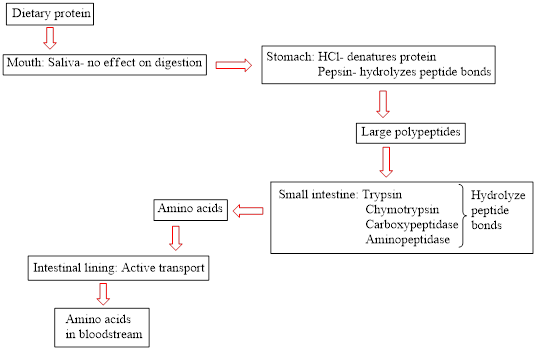
Concept explainers
(a)
Interpretation: To identify whether the statement “gastrin is a hormone released by stomach mucosa cells” relating to protein digestion is true or false.
Concept introduction: Proteins are natural biopolymers. Amino acids are the main building block of protein molecules. A large number of amino acids condense together to form a polypeptide chain. A large polypeptide chain is called protein. The digestion of dietary protein starts in the stomach and is completed in the small intestine. It does not start in the mouth because saliva present in the mouth does not contain an effective enzyme to break down the protein. The flow chart for protein digestion in the human body is as follows:

(b)
Interpretation: To identify whether the statement “approximately
Concept introduction: Proteins are natural biopolymers. Amino acids are the main building block of protein molecules. A large number of amino acids condense together to form a polypeptide chain. A large polypeptide chain is called protein. The digestion of dietary protein starts in the stomach and is completed in the small intestine. It does not start in the mouth because saliva present in the mouth does not contain an effective enzyme to break down the protein. The flow chart for protein digestion in the human body is as follows:

(c)
Interpretation: To identify whether the statement “hydrochloric acid functions as a denaturing agent in the stomach” relating to protein digestion is true or false.
Concept introduction: Proteins are natural biopolymers. Amino acids are the main building block of protein molecules. A large number of amino acids condense together to form a polypeptide chain. A large polypeptide chain is called protein. The digestion of dietary protein starts in the stomach and is completed in the small intestine. It does not start in the mouth because saliva present in the mouth does not contain an effective enzyme to break down the protein. The flow chart for protein digestion in the human body is as follows:

(d)
Interpretation: To identify whether the statement “pancreatic digestive enzymes include carboxypeptidase and aminopeptidase” relating to protein digestion is true or false.
Concept introduction: Proteins are natural biopolymers. Amino acids are the main building block of protein molecules. A large number of amino acids condense together to form a polypeptide chain. A large polypeptide chain is called protein. The digestion of dietary protein starts in the stomach and is completed in the small intestine. It does not start in the mouth because saliva present in the mouth does not contain an effective enzyme to break down the protein.
The flow chart for protein digestion in the human body is as follows:

Want to see the full answer?
Check out a sample textbook solution
Chapter 26 Solutions
General, Organic, and Biological Chemistry
- In the decomposition reaction in solution B → C, only species C absorbs UV radiation, but neither B nor the solvent absorbs. If we call At the absorbance measured at any time, A0 the absorbance at the beginning of the reaction, and A∞ the absorbance at the end of the reaction, which of the expressions is valid? We assume that Beer's law is fulfilled.arrow_forward> You are trying to decide if there is a single reagent you can add that will make the following synthesis possible without any other major side products: 1. ☑ CI 2. H3O+ O Draw the missing reagent X you think will make this synthesis work in the drawing area below. If there is no reagent that will make your desired product in good yield or without complications, just check the box under the drawing area and leave it blank. Click and drag to start drawing a structure. Explanation Check ? DO 18 Ar B © 2025 McGraw Hill LLC. All Rights Reserved. Terms of Use | Privacy Center | Accessibilityarrow_forwardDon't use ai to answer I will report you answerarrow_forward
- Consider a solution of 0.00304 moles of 4-nitrobenzoic acid (pKa = 3.442) dissolved in 25 mL water and titrated with 0.0991 M NaOH. Calculate the pH at the equivalence pointarrow_forwardWhat is the name of the following compound? SiMe3arrow_forwardK Draw the starting structure that would lead to the major product shown under the provided conditions. Drawing 1. NaNH2 2. PhCH2Br 4 57°F Sunny Q Searcharrow_forward
- 7 Draw the starting alkyl bromide that would produce this alkyne under these conditions. F Drawing 1. NaNH2, A 2. H3O+ £ 4 Temps to rise Tomorrow Q Search H2arrow_forward7 Comment on the general features of the predicted (extremely simplified) ¹H- NMR spectrum of lycopene that is provided below. 00 6 57 PPM 3 2 1 0arrow_forwardIndicate the compound formula: dimethyl iodide (propyl) sulfonium.arrow_forward
 Chemistry for Today: General, Organic, and Bioche...ChemistryISBN:9781305960060Author:Spencer L. Seager, Michael R. Slabaugh, Maren S. HansenPublisher:Cengage Learning
Chemistry for Today: General, Organic, and Bioche...ChemistryISBN:9781305960060Author:Spencer L. Seager, Michael R. Slabaugh, Maren S. HansenPublisher:Cengage Learning General, Organic, and Biological ChemistryChemistryISBN:9781285853918Author:H. Stephen StokerPublisher:Cengage Learning
General, Organic, and Biological ChemistryChemistryISBN:9781285853918Author:H. Stephen StokerPublisher:Cengage Learning Organic And Biological ChemistryChemistryISBN:9781305081079Author:STOKER, H. Stephen (howard Stephen)Publisher:Cengage Learning,
Organic And Biological ChemistryChemistryISBN:9781305081079Author:STOKER, H. Stephen (howard Stephen)Publisher:Cengage Learning,
 World of Chemistry, 3rd editionChemistryISBN:9781133109655Author:Steven S. Zumdahl, Susan L. Zumdahl, Donald J. DeCostePublisher:Brooks / Cole / Cengage Learning
World of Chemistry, 3rd editionChemistryISBN:9781133109655Author:Steven S. Zumdahl, Susan L. Zumdahl, Donald J. DeCostePublisher:Brooks / Cole / Cengage Learning Introduction to General, Organic and BiochemistryChemistryISBN:9781285869759Author:Frederick A. Bettelheim, William H. Brown, Mary K. Campbell, Shawn O. Farrell, Omar TorresPublisher:Cengage Learning
Introduction to General, Organic and BiochemistryChemistryISBN:9781285869759Author:Frederick A. Bettelheim, William H. Brown, Mary K. Campbell, Shawn O. Farrell, Omar TorresPublisher:Cengage Learning





